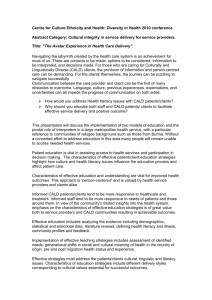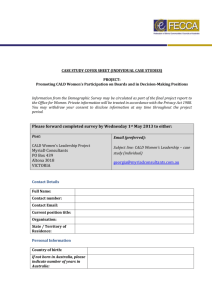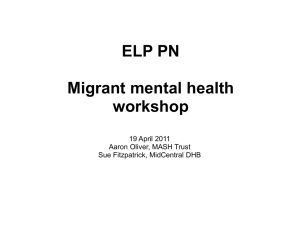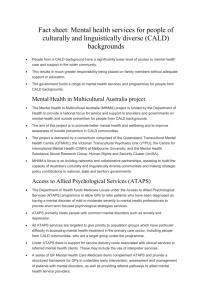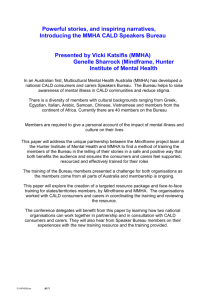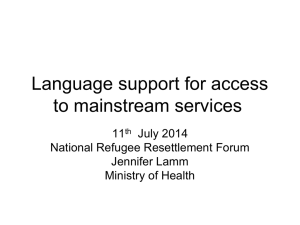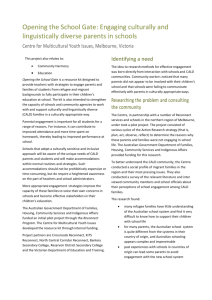Participation, partnerships, respect and resilience
advertisement
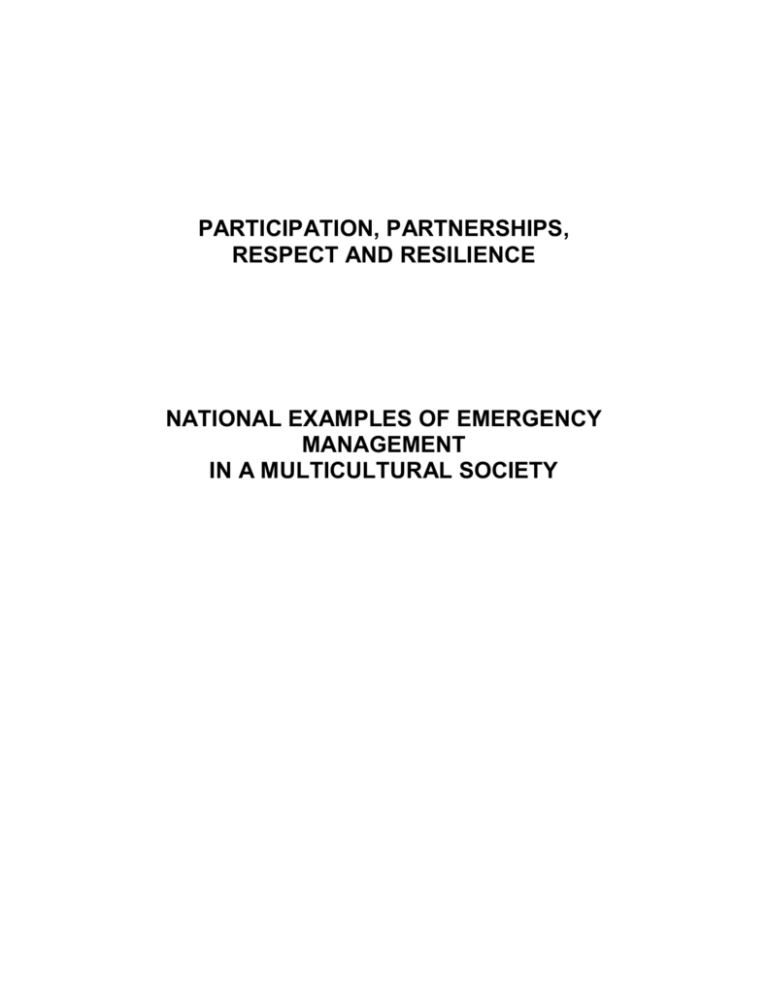
PARTICIPATION, PARTNERSHIPS, RESPECT AND RESILIENCE NATIONAL EXAMPLES OF EMERGENCY MANAGEMENT IN A MULTICULTURAL SOCIETY Foreword It is recognised that reducing community vulnerability to disasters depends on engaging and addressing issues specific to all segments of the population. Australia’s population is one of the most culturally and linguistically diverse in the world and includes people from about 200 countries. This publication promotes the achievements of Jurisdictional Community Partnership projects that specifically address this diversity in the context of emergency management and national security. These projects have been implemented as part of the Attorney-General’s Department program Inclusive Emergency Management with Culturally and Linguistically Diverse (CALD) Communities. The program is funded through the Australian Government’s National Action Plan to Build on Social Cohesion, Harmony and Security and comprises a range of national activities and partnerships that aim to enhance CALD community resilience to the adverse effects of disasters. It addresses issues relating to community awareness, prevention and preparedness through the development of culturally inclusive emergency management school resources, strategies to encourage and support community members to volunteer in emergency management roles, and local community projects in each jurisdiction. An integral element of this program is the building of trust and relationships through increased engagement between the emergency management and culturally and linguistically diverse community sectors. The Jurisdictional Community Partnership projects specifically address this element, encouraging mutual learning and understanding through locally based initiatives involving both emergency management and community organisations in each state and territory. Together they have worked to design and implement projects that build community awareness and resilience through increased participation, respect and solid partnerships. The dynamic and evolving nature of the projects and their capacity to reach out to a broad crosssection of culturally and linguistically diverse communities, which are potentially vulnerable in an emergency, is evident in the samples of work included in this publication. I congratulate all involved for their commitment to these projects and am confident that the following examples will provide a solid basis for ongoing CALD community engagement in emergency management nationally and contribute to strengthening social inclusion and disaster resilience in Australia. Miles Jordana Deputy Secretary National Security and Criminal Justice Groupty Attorney-General’s Department Introduction The Attorney-General’s Department, through the Australian Emergency Management Institute, has worked to build emergency management capability to engage with multicultural communities in addressing their needs in relation to dealing with disasters. Jurisdictional Community Partnership projects were piloted in 2005/2006 as action learning projects with the overall objective of increasing engagement between the emergency management and multicultural sectors. The success of these projects in delivering positive results at a local level was clearly evident and indicated potential for further development. With the provision of funding through the Australian Government’s National Action Plan to Build on Social Cohesion, Harmony and Security, the community partnership project concept was able to continue in 2006 through 2010 as a component of the Inclusive Emergency Management with Culturally and Linguistically Diverse (CALD) Communities program. Eight projects have been initiated across Australia using different models of community engagement relevant to their jurisdiction and community needs. The projects involve community consultation and activities ranging from workshops to expos, participation in exercises, conferences and the development of resources. The project methodology is outlined on page 20. A mid-term evaluation undertaken by the Centre for Program Evaluation at The University of Melbourne stated “. . . the Program has demonstrated that practical interventions mainly targeted at ‘grassroots’ community groups and CALD communities, can increase knowledge and confidence amongst community members and begin to change attitudes and behaviour within both CALD communities and [emergency management] organisations (Farrow, Rutter & Hurworth 2009: xiii).” The evaluation showed that project participants particularly valued the benefit of new relationships, networks and the opportunities for greater collaboration. At the 2009 annual workshop, the project participants recognised that a fundamental shift from ‘information transfer to relationships’ had occurred (Attorney-General’s Department 2009: 15). These projects provide a unique opportunity for all states and territories across Australia to harness the current work being undertaken by a broad range of emergency management organisations in partnership with CALD communities, to build CALD community disaster resilience. They have established a framework for future CALD community partnering and collaboration. Project Outcomes The Jurisdictional Community Partnership projects are enabling a more inclusive and appropriate service delivery that builds disaster resilient communities nationally through: greater opportunities for interaction between emergency management organisations and CALD communities that break down barriers and encourage participation stronger relationships between emergency management organisations and CALD communities enhanced partnerships with multicultural organisations and communities nationally increased transfer of knowledge between emergency management and CALD communities improved awareness of emergency management and the organisations involved within CALD communities greater CALD community involvement and empowerment in preparedness, response and recovery phases of emergencies greater cross-cultural awareness within emergency management organisations a national network to share lessons learned and to contribute to a wider knowledge of issues relating to emergency management and CALD community engagement. Key Principles To Inform Future Work utilise a community development approach to identify strategies to involve CALD communities in all phases of emergency management incorporate diversity approaches into the core work of organisations involved in emergency management create collaborative and equal relationships learn from communities and utilise their experiences to contribute to building resilience in an Australian context acknowledge the complexity of diversity within communities provide for program evaluation and review link good practice with government policy Community Consultation Connecting Through Respect The Jurisdictional Community Partnership (JCP) projects form national examples of emergency management in a multicultural society. This section outlines community consultations in each state and territory. A full list of project partners for each state and territory appears on page 21. Australian Capital Territory The Australian Capital Territory project partners worked together to engage representatives across the range of CALD communities living in the Australian Capital Territory. In June 2007 a workshop was conducted by the Australian Capital Territory Council of Social Services in conjunction with the Australian Capital Territory Emergency Services Agency (ACT ESA) and the Canberra Multicultural Community Forum, to begin the process. Fundamental questions such as, “What happens in an emergency?” and “What can help?”, were explored. It was recognised that community involvement and preparation were key and “a shared responsibility” was required for effective emergency management. Further information and consultation forums, organised with the support of the Migrant and Refugee Settlement Services ACT and the Office of Multicultural Affairs, were held with community leaders. The events were positively received by the community leaders and assisted the project team to expand its community contacts. New South Wales The New South Wales Project team decided to focus on recovery aspects of an emergency, looking at how new and emerging communities would recover and how they would communicate assistance requirements. Twelve communities were identified to be involved in a pilot project, including the Somali, Ethiopian, Liberian, Sierra Leonean, Sudanese, Congolese and Burundi communities, and the Pashtun, Hazara and Tushcun ethnic groups from Afghanistan. Twenty-five bilingual workers from the target communities were trained to assist in the community consultations. Northern Territory Partnerships with CALD community-based agencies provided much support and guidance to the Northern Territory project. Consultations held with multicultural support services identified strong interest within communities to facilitate the delivery of emergency management programs. In particular, they were concerned about limited access to information about the nature of emergencies in the Territory and relevant response procedures. To start to address this, the project team undertook a detailed research study on effective approaches for emergency management communication with CALD communities. Queensland The Community Engagement Unit within the Department of Emergency Services worked closely with Muslim Youth Services, part of the Queensland Government’s Muslim Community Engagement Strategy, to develop an emergency management framework for Queensland’s Muslim Communities. Initial consultation through the Queensland Muslim Community Reference Group provided valuable feedback and linkages. Further consultation involving the Crescents of Brisbane, a community organisation, identified an opportunity for a communication campaign to improve Muslim community awareness in accessing emergency management agencies in a disaster. Numerous campaign activities and strategies were brainstormed including suitable distribution linkages and contacts. South Australia Members of South Australia’s working group undertook a series of consultation and engagement activities to successfully involve members of a multicultural community in an emergency management exercise. The exercise, labelled “Stuffed Goose” simulated a major bushfire threatening the regional centre of Murray Bridge. Initial consultation was through the Murraylands Multicultural Network as identified by the Migrant Resource Centre of South Australia. The network is part of the centre’s regional program to support refugee and migrant settlement groups in the Murraylands district, which includes Murray Bridge. A brief overview of the exercise was provided at a meeting to inform network members of potential areas in which community members could be involved. A briefing on emergency management and further information regarding the exercise was later provided for those who were interested. A total of nine people attended the briefing and a number of these nominated to be involved and were provided with comprehensive details confirming the time, venue and so on in relation to the activity. They were also provided with feedback sheets to complete after their participation to allow for project evaluation and further improvement. Tasmania The Tasmanian project team worked collaboratively with stakeholders at the outset to determine project outcomes. The Migrant Resource Centre of Southern Tasmania played a key project management role, using its trusted position within the community and the relationship built with stakeholders during the pilot project in 2005/2006. Individual consultations with emergency management agencies and CALD communities were conducted to seek alignment between the planned outcomes and respective needs. A needs matrix was developed through the community consultation process. Engagement methods were then tailored accordingly. Victoria The Victorian project team recognised that there was a lack of documentation outlining the range of projects – past, current and future – involving CALD community engagement in relation to emergency management, which hindered effective engagement. The team organised a meeting with the CALD network of emergency services administered by the Office of the Emergency Services Commissioner to develop the parameters for a mapping exercise that commenced the documentation process. Western Australia A demographic mapping of CALD communities was seen by the Western Australian working group as a vital first step to ensure consultation processes reflect the main CALD community groups in the population. The mapping project was used to guide the selection of CALD community groups to be involved in a series of forums to identify actions to build community capacity around the four key components of emergency management. Consultation was on both a locality and individual community basis. Forums were held with Dinka and Bari Community leaders, City of Wanneroo council representatives, the Local Emergency Management Committee, and Padang , Rumbek (Sudanese) and Burmese Chin communities. Community Engagement Initiatives Positive Participation and Partnerships in Action This section details the activities – ranging from workshops to expos, exercises and conferences – that were undertaken by the Jurisdictional Community Partnership projects. These community engagement initiatives aimed to encourage positive participation and partnerships in action. Australian Capital Territory The Australian Capital Territory project team implemented a number of community engagement activities. An information session was organised by the Migrant Resource Centre of Canberra and Queanbeyan and ACT ESA. Representatives from emergency management agencies were present to help refugees, migrants and humanitarian entrants prepare for an emergency. A partnership between ACT ESA and the Canberra Multicultural Community Forum to devise the best ways to distribute emergency information was reported in the Community News section of the Canberra Chronicle. Featuring the Police and Emergency Services Minister and Chairman of the Community Multicultural Forum, it signalled a commitment to ensuring CALD communities had the most up-to-date information. As a direct result of the JCP project, ACT ESA employed a CALD Liaison Officer to work with local CALD community representatives to help distribute vital emergency preparedness information. This commitment has realised the following opportunities to date: stalls at the Australian National University, University of Canberra and Canberra Institute of Technology for orientation/open days a stall for the family day event during NAIDOC week NAIDOC in the Peninsula’ event day interviews and community messages on multicultural radio station FM 91.1 CMS and the Chinese language Radio FM88 a stall at the Australian Institute of Aboriginal and Torres Strait Islanders Studies together with the National Museum of Australia an information session for a Polish Seniors group information sessions for aged care and disability carers. Regular attendance at Canberra’s annual Multicultural Festival has provided valuable interaction where members of the community can ask questions, obtain information and meet with uniformed emergency services personnel in a non-threatening environment. ACT ESA and the Australian Federal Police recognised the mutual benefits of working together and regularly deliver information sessions to reduce duplication and to more effectively manage community engagement. This outreach has prompted proactive work by CALD community leaders and representatives to ensure that ACT ESA and the Australian Federal Police have ample opportunity to present emergency information to their communities in Canberra. In October 2009 the project team held a one-day conference involving representatives from the CALD and Emergency Management sectors, with the key purpose of jointly working towards future directions in inclusive emergency management. Guest speakers shared information about the various organisational roles in emergency management and community experience. Group discussions explored five key areas: building partnerships and improving relationships with multicultural organisations building cultural capabilities in emergency services engaging newly arrived communities engaging faith communities developing effective diversity communication and information resources New South Wales An introduction to emergency management was provided to more than 60 community leaders and active community members at the Baulkham Hills Holroyd Parramatta Migrant Resource Centre in March 2008. The training was facilitated by the District Emergency Management Officer of the New South Wales Police and covered the topics, “What is an Emergency?”, The role of community leaders in an emergency and Emergency Services in New South Wales. CALD communities represented, included those from Sudan, Sierra Leone, Somalia, Liberia, Afghanistan, Iran, Sri Lanka, Bangladesh, Turkey, Palestine, and Iraq. Through the delivery of this training a strong partnership has developed between the Baulkham Hills Holroyd Parramatta Migrant Resource Centre and the New South Wales Fire Brigades. Together they have continued to build CALD community awareness and understanding of emergency management. In March 2008 they held an expo at Holroyd to provide the local communities with the opportunity to interact with members of emergency management organisations. In October 2009 a similar expo, held in Parramatta Park, aimed to help CALD communities understand the role of emergency services in the community - the work they do, how to prevent and prepare for emergencies and possible career opportunities. It was a familyfocused event with activities provided for children, along with displays and interactive presentations by the New South Wales Police, Rural Fire Service, State Emergency Service, Ambulance Service of New South Wales, Red Cross, New South Wales Fire Brigades and Parramatta Rotary. The local communities were encouraged by the Federal Minister for Parramatta and the Lord Mayor to talk with the emergency services personnel. The Expo was attended by approximately 600 people from various CALD backgrounds, including Sudanese, Afghan and Syrian communities, just to name a few. South Australia Six women from the local Filipino community volunteered to participate in the emergency management exercise, “Stuffed Goose”, in the following areas: as observers at the Zone Emergency Centre as volunteer ‘disaster affected persons’ or as a ‘meeter and greeter’ (a role usually undertaken by the Australian Red Cross) within the Recovery Centre. Key outcomes for CALD community members participating in this activity included: increased knowledge of fire safety and managing emergencies learning about emergency service organisations, particularly the need for communication between the agencies a feeling of confidence in attending a Zone Emergency Centre and Recovery Centre confidence in the ability to take on a role of informing local CALD community members about recovery centres, and what will be available there a willingness to assist in the ‘meet and greet’ element of a recovery centre. Tasmania Three highly successful community workshops were delivered in 2008. The community needs matrix identified the following communities as high needs based on their English proficiency and relatively recent arrival in Australia: Congolese, Burundi, Ethiopian, Sudanese and Afghani. The workshops aimed to introduce the communities to the range of services that might be involved in an emergency and individual agency messages. Emergency management agencies presented information sessions and interactive displays, and provided site tours. Community members had many opportunities to interact with agency staff and familiarise themselves with routines, resources and equipment used in an emergency. The project team identified a key outcome of this project as the recognition by emergency management organisations of the value in building relationships with the Migrant Resource Centre and CALD communities. Victoria The Victorian project team designed and held a workshop entitled Building Emergency Management Capacity for CALD Communities. This workshop aimed to develop a framework to help the emergency services to build emergency management capacity within CALD communities. The workshop also acted as a conduit for representatives from the community and the emergency management sector to share perspectives, discuss opportunities and make connections with other relevant industry contacts. A key feature of the workshop included the presentation of successful models of emergency management initiatives with CALD communities by the Maribyrnong City Council and the Jewish Emergency Management Plan.. Western Australia Informed by the demographic mapping phase of the Western Australian project, the project’s working group proposed two pilot projects to model a geographical and community-based engagement process. A joint funding application by the Fire and Emergency Services Authority of Western Australia (FESA) and the Metropolitan Migrant Resource Centre was successful, and a part-time Project Officer was employed to help develop and implement the pilot projects. Educational forums were run for community leaders to provide an overview of emergency management and discuss particular issues around the key concepts of Prevention, Preparedness, Response and Recovery, with the following format: introduction overview of project overview of local emergency management arrangements areas for improvement in arrangements for CALD communities explanation of four concepts – Prevention, Preparedness, Response and Recovery example scenarios for discussion to identify issues and challenges to effective CALD community engagement The response from the communities has been extremely positive, with many comments centred on how important the information was to all families. Members of the working group presented their JCP project at the Western Australian Emergency Management Conference – Learning from the Past to Prepare for the Future – in April 2009. The working group also ran two one-day forums for the emergency management sector, Diversity Perspectives on Emergency Management and Trauma – A Focus on Organisation and Community Capacities. Over 150 people attended these sessions. Resource Development Tools for Building Resilient Communities This section details the resources that resulted from the implementation of the Jurisdictional Community Partnership projects. These resources are seen as tools for building resilient communities. Australian Capital Territory A variety of promotional and informative resources have been developed. A brochure developed by ACT ESA and the Australian Federal Police provides key information on the roles of emergency services and contact details. A community newsletter, Your Emergency, Our Emergency, has been developed by ACT ESA to provide clear and concise information to improve community safety. The newsletter is distributed widely via the Multicultural and Aboriginal and Torres Strait Islander Affairs’ network. Northern Territory Darwin Culturally and Linguistically Diverse Communities and Emergency Management Effective Communication, Preliminary Study – 2010 is a resource document that has been drafted by the Northern Territory project working group, based on the successful concept developed by the Western Australian project team. This preliminary study aims to identify CALD communities within the Darwin region that are most vulnerable to the impact of emergencies to enable more targeted engagement initiatives. South Australia South Australia’s Inclusive Emergency Management with CALD Communities Report 2007 outlines the involvement of CALD community members in an emergency management exercise and identifies a number of critical factors to enhance the sector’s response to CALD. Key points highlighted in the report include: having access to interpreters for identified nationalities within communities is critical to the success of managing an emergency safely and inclusively women who are housebound and workers isolated from the community (such as 457 Visa holders) are most likely to have low or non-existent English skills and are therefore more at risk in an emergency situation emergency Service Organisations should be notified where there are significant CALD communities identified and a CALD Register should be created with up-to-date contact lists, agencies, useful networks, support groups and individuals who can assist in an emergency situation picture cards (or Crisis Communication Cards) showing emergency pictures and actions and accompanied by translation in various languages would be useful for emergency workers, and could be standard equipment on all Emergency Service vehicles local support groups could be formed from interested residents from a variety of ethnic backgrounds and could be trained to appropriately facilitate emergency management within their communities. Victoria A preliminary mapping exercise and a cultural diversity paper were developed to guide and determine a communication strategy for CALD communities in Victoria. The mapping exercise documented Victoria’s emergency management sector’s engagement activities with CALD communities and provided a comparative analysis of the findings. This highlighted a range of strategies that characterise success in communicating and engaging effectively. The strategies include: partnerships that reflect equity in involvement, contribution and decision making a focus on communication themes/topics that reflect the direct needs of communities testing proposed communication methodologies, especially the effectiveness of key messages and translated materials involving CALD communities in planning phases observing and respecting community protocols in approaching specific CALD community groups opportunities for direct contact and experiential learning holistic approaches involving agencies working in unison (with communities) The diversity paper was developed as a result of the Building Emergency Management Capacity for CALD Communities workshop, which was held in November 2008. The paper details risk perception and preparedness in diverse communities and the barriers these communities encounter when accessing emergency services. It provides some best practice examples of the emergency management sector working with culturally diverse communities. Overall, the paper recognises the need for a tailored approach for different communities and the importance of continual education that emphasises safety messages. Western Australia Understanding Emergency Management, A Dialogue Between Emergency Management Sector and CALD Communities is a practical guidebook for emergency management organisations. It presents the results of desktop research aimed at developing a state-wide demographic CALD community profile, including identification of CALD communities in Western Australia, and an overview of religions, languages and cultural issues as they relate to emergency management. A review of relevant Australian and overseas literature is also provided. A Home Fire Safety DVD, which will be translated into 11 of the top new and emerging community languages, is being developed. Awards Celebrating CALD Community Engagement The Australian Safer Communities Awards are sponsored by the Australian Government Attorney-General’s Department, in conjunction with states and territories. They recognise best practice and innovation by organisations and individuals that help to build safer communities across Australia. The awards cover all aspects of community safety in the context of emergency management including: risk assessment research education and training information and knowledge management prevention, preparedness, response and recovery. The awards are judged on two levels - state and territory winners are decided and recognised first, and in turn become finalists for the National Awards. The 2009 Awards were presented by the Attorney General, The Hon Robert McClelland MP, in Old Parliament House in Canberra on Thursday 3 December. ACT National Winner The ACT project team were national award winners for their JCP project in the 2009 Australian Safer Communities Awards in the State/Territory Government Agencies section . Tasmania State/Territory Winner and National Highly Commended Award The Migrant Resource Centre of Southern Tasmania was presented with the 2009 Tasmanian Safer Communities Award, for their JCP project in the Private Sector category on September 25th, 2009. The award was presented by the Minister for Police and Emergency Management – the Hon Jim Cox. The Migrant Resource Centre of Southern Tasmania was then presented with a Highly Commended Award in the 2009 Australian Safer Communities Awards in the Not for Profit Organisations Section. VIC – STATE/TERRITORY WINNER – A winner in the 2009 Victorian Safer Communities Awards was the Uniformed Services in Your Community Expo, which implemented one of the key successes (to provide opportunities for direct interaction and experiential learning) identified in the Victorian project team’s mapping exercise. The expo was a partnership project between the Metropolitan Fire Brigade, the cities of Darebin and Whittlesea, and the Office of the Emergency Services Commissioner, and was held in the northern region of metropolitan Melbourne in 2009. The expo was designed to expose diverse communities Project Methodology The Jurisdictional Community Partnership projects build CALD community resilience primarily through strengthened engagement between the emergency management and CALD community sectors. These projects have been developed on the basis of equal participation and genuine partnerships, bringing stakeholders together to work towards common goals that build respect and community resilience. Recognising that learning transference as a result of engagement is likely to influence our thinking in work practices and thereby lead to individual and organisational growth and development, an action learning approach has been applied to the projects. This has enabled greater flexibility and responsiveness to partner needs and provides a basis for sustainable development. Project teams within states and territories were established in 2007 at the National Workshop of the Inclusive Emergency Management with Culturally and Linguistically Diverse (CALD) Communities program. They comprise representatives from emergency management and CALD community organisations. A full list of the partners in each project team is provided at page 21. While each team was responsible for developing its project to meet local needs, all projects were required to meet the following eligibility criteria: projects must be informed by the overall objective of bringing emergency management and CALD community sectors together a multi-agency response/contribution is essential projects should fit into prevention, preparedness, response or recovery areas emergency situations/areas to be addressed in the proposed projects should reflect ‘emergency’ as it is defined by Emergency Management Australia. Planning workshops were held in each state and territory following the National Workshop to further plan the projects and allow for wider input across the range of stakeholders in each jurisdiction. Seed funding was provided to each team at the initiation phase, with all further resources committed by project team agency partners. Ongoing mentoring and support has been provided by cultural diversity experts and program coordinators. Annual workshops were held at the Australian Emergency Management Institute in June 2008 and 2009 to strengthen networks and overall professional development in emergency management and CALD community engagement. The workshops provided an opportunity for project participants to come together to exchange information, stories and learning that promote and encourage the replication of good practice. The workshops included a half-day session entitled ‘It’s all about context—emergency management and the challenge of diversity capability, resilience and negotiation’, which was presented by an accredited diversity trainer, and a session presented by the Centre for Program Evaluation, The University of Melbourne, describing the program logic framework to enable better program evaluation. The JCP projects were evaluated by the Centre for Program Evaluation in June 2009. The report, Evaluation of the Inclusive Emergency Management with Culturally and Linguistically Diverse (CALD) Communities program (Farrow, Rutter & Hurworth 2009), is available on the Emergency Management in Australia website (www.ema.gov.au). Project Partners AUSTRALIAN CAPITAL TERRITORY Royal Bluebell - Wahlenbergia gloriosa ACT Emergency Services Agency (ACT Ambulance, ACT Fire Brigade, ACT Rural Fire Service, ACT State Emergency Service) Australian Federal Police Canberra Multicultural Community Forum Migrant and Refugee Settlement Services of the ACT Inc Office of Multicultural Affairs - Department of Disability Housing and Community Services ACT NEW SOUTH WALES Waratah - Telopea speciosissima Baulkham Hills Holroyd Parramatta Migrant Resource Centre Community Relations Commission For a multicultural NSW Emergency Management NSW (formerly Office for Emergency Services NSW) NSW Fire Brigades NSW Police NORTHERN TERRITORY Sturt’s Desert Rose - Gossypium sturtianum Anglicare Department of Health and Families NT Indian Cultural Society Melaleuca Refugee Centre Menzies School of Health Multicultural Council NT NT Ambulance Service NT Police Fire and Emergency Services (NTPFES) Red Cross NT QUEENSLAND Cooktown Orchid - Dendrobium phalaenopsis Crescents of Brisbane Department of Communities (DoC), Multicultural Affairs Queensland (MAQ) Department of Community Safety (previously Department of Emergency Services), Media and Corporate Communications Department of Emergency Services Qld, Community Engagement Unit Islamic Women’s Association of Queensland (IWAQ) Muslim Youth Services Queensland Muslim Community Reference Group Queensland Police Service (QPS) SOUTH AUSTRALIA Sturt’s Desert Pea - Swainsona formosa Department of Families and Communities – State Recovery Office Metropolitan Fire Service SA Migrant Resource Centre SA Multicultural SA TASMANIA Tasmanian Blue Gum - Eucalyptus globulus Department of Health and Human Services TAS Department of Immigration and Citizenship (TAS) Department of Premier and Cabinet TAS Migrant Resource Centre Southern Tasmania Multicultural Tasmania (MultiTas) Tasmania Fire Services Tasmania Police Tasmania State Emergency Services (SES) VICTORIA Common Heath - Epacris impressa Department of Human Services (DHS) Department of Immigration and Citizenship (VIC) Ethnic Communities’ Council of Victoria (ECCV) Islamic Council of Victoria (ICV) Metropolitan Fire Brigade (MFB) Office of the Emergency Services Commissioner (OESC) Victoria Police Victorian Multicultural Commission (VMC) WESTERN AUSTRALIA Red and Green Kangaroo Paw - Anigozanthos manglesii City of Joondalup City of Wanneroo Department of Child Protection Fire and Emergency Services Agency (FESA) Metropolitan Migrant Resource Centre WA Murdoch University Office of Multicultural Interests Red Cross Western Australia Local Government Association (WALGA) Western Australia Police (WAPol)
